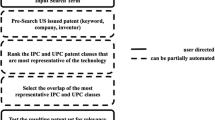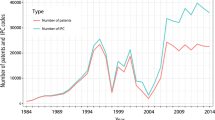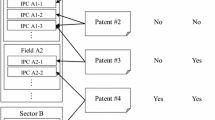Abstract
Intensified technology convergence, increasing relatedness between technological fields, is a mega-trend in 21st century science and technology. However, scientometrics has been unsuccessful in identifying this techno-economic paradigm change. To address the limitations and validity problems of conventional measures of technology convergence, we introduce a multi-dimensional contingency table representation of technological field co-occurrence and a relatedness measure based on the Mantel–Haenszel common log odds ratio. We used Korean patent data to compare previous and proposed methods. Results show that the proposed method can increase understanding of the techno-economic paradigm change because it reveals significant changes in technological relatedness over time.







Similar content being viewed by others
Notes
Because most countries other than the United States use a first-to-file system, which grants a patent for a given invention to the first applicant of that invention, inventors are more pressured to prepare and file the application as soon as possible. Therefore, the application date of a patent best reflects the timing of the invention.
The IPC entered into force in 1975, under the Strasbourg Agreement of 1971, and it is currently being used in more than 100 countries. Korean Intellectual Property Office adopted IPC system in 1980.
The analysis of patent classification data may be distorted by an “indexer bias” (Healey et al. 1986). However, the indexer bias in patent classification data is partly controlled by the strict guidelines and systematic process of IPC assignment.
C ij is treated as zero or missing, because it does not indicate the frequency of co-occurrence (Mccain 1991).
Nevertheless, all the information the raw data proffer is not fully utilized, because classification analysis focuses on if two focal TFs co-occur or not, and neglects other TFs’ occurrences.
A comprehensive introduction to categorical data analysis is well beyond the scope of this paper. We refer readers to Agresti (2002) for details of categorical data analysis.
Associations between two categorical variables can be measured by either an odds ratio or log-linear models. When C is small, relatedness between TFs can be measured by estimating first-order interaction terms of a quasi log-linear model. The quasi log-linear model for a 2C contingency table has 1 + C + C × (C − 1)/2 parameters to be estimated, and the quasi log-linear model for this example has 11 parameters. Because the number of parameters to be estimated sharply increases as C increases, it is practically impossible to apply a quasi log-linear model to measure relatedness between TFs.
See Table 2.
Relatedness between technological fields measured by four different measures over four periods will be provided by request.
Two technological fields can be found negatively related by the Mantel–Haenszel common odds ratio (M ij ), however, no pair of technological fields is negatively related at p < 0.01. The pair of technological fields that negatively related most strongly has the p-value of 0.45.
The results of S ij , R ij and τ ij will be provided by request.
References
Acs, Z. J., & Audretsch, D. B. (1989). Patents as a measure of innovative activity. Kyklos, 42(2), 171–180.
Agresti, A. (2002). Categorical data analysis. New York: Wiley-Interscience.
Breschi, S., Lissoni, F., & Malerba, F. (2003). Knowledge-relatedness in firm technological diversification. Research Policy, 32(1), 69–87.
Cochran, W. G. (1954). Some methods for strengthening the common χ2 tests. Biometrics, 10, 417–451.
Cockburn, I. M., Kortum, S. S., & Stern, S. (2002). Are all patent examiners equal? The impact of examiner characteristics. Working paper no. 8089. Cambridge, MA: NBER.
Criscuolo, P., & Verspagen, B. (2005). Does it matter where patent citations come from? Inventor versus examiner citations in European patents. Working Paper 05.06. Eindhoven, The Netherlands: Eindhoven Centre for Innovation Studies.
Eaton, J., & Kortum, S. (1996). Trade in ideas: Patenting and productivity in the OECD. Journal of International Economics, 40(3–4), 251–278.
Engelsman, E. C., & Van Raan, A. F. J. (1994). A patent-based cartography of technology. Research Policy, 23(1), 1–26.
European Commission. (2003). Third European report on science & technology indicators. Brussels: European Commission.
Fienberg, S. E. (1972). The analysis of incomplete multi-way contingency tables. Biometrics, 28(1), 177–202.
Goodman, L. A. (1968). The analysis of cross-classified data: Independence, quasi-independence, and interactions in contingency tables with or without missing entries. Journal of the American Statistical Association, 63(324), 1091–1131.
Griliches, Z. (1990). Patent statistics as economic indicators: A survey. Journal of Economic Literature, 28(4), 1661–1707.
Grupp, H. (1998). Foundations of the economics of innovation: Theory, measurement and practice. Cheltenham: Edward Elgar.
Healey, P., Rothman, H., & Hoch, P. K. (1986). An experiment in science mapping for research planning. Research Policy, 15(5), 233–251.
Kamada, T., & Kawai, S. (1989). An algorithm for drawing general undirected graphs. Information Processing Letters, 31(1), 7–15.
Khan, M., & Dernis, H. (2006). Global overview of innovative activities from the patent indicators perspective. OECD Science, Technology and Industry working papers 2006/3. OECD, Directorate for Science, Technology and Industry.
Kleinbaum, D. G., Kupper, L. L., & Morgenstern, H. (1982). Epidemiologic research. Belmont, CA: Lifetime Learning.
Korean Intellectual Property Office. (2008). Guide to the examination of patent and utility design. Taejon: Korea Intellectual Property Office. (in Korean).
Kuhn, T. S. (1962). The structure of scientific revolutions. Chicago: University of Chicago Press.
Leydesdorff, L. (1995). The challenge of scientometrics: The development, measurement, and self-organization of scientific communications. Leiden: DSWO Press, Leiden University.
Leydesdorff, L. (2008). Patent classifications as indicators of intellectual organization. Journal of the American Society for Information Science and Technology, 59(10), 1582–1597.
Leydesdorff, L., & Schank, T. (2009). Tracing “interdisciplinarity” using time series of journal maps: The visualization and dynamic animation of journal–journal citation relations. Proceedings of the American Society for Information Science and Technology, 45(1), 1–8.
Leydesdorff, L., & Vaughan, L. (2006). Co-occurrence matrices and their applications in information science: Extending ACA to the web environment. Journal of the American Society for Information Science and Technology, 57(12), 1616–1628.
Lorrain, F., & White, H. C. (1971). Structural equivalence of individuals in social networks. Journal of Mathematical Sociology, 1, 49–80.
Mantel, N., & Haenszel, W. (1959). Statistical aspects of the analysis of data from retrospective studies of disease. Journal of the National Cancer Institute, 22, 719–748.
Mccain, K. W. (1991). Mapping economics through the journal literature: An experiment in journal cocitation analysis. Journal of the American Society for Information Science, 42(4), 290–296.
Meyer, M. (2000). What is special about patent citation? Differences between scientific and patent citations. Scientometrics, 49(1), 93–123.
Mosier, C. I. (1947). A critical examination of the concepts of face validity. Educational and Psychological Measurement, 7, 191–205.
Nesta, L., & Saviotti, P. P. (2005). The coherence of the knowledge base and the firms’ innovative performance: Evidence from the bio-pharmaceutical industry. The Journal of Industrial Economics, 53(1), 123–142.
Noma, E. (1982). An improved method for analyzing square scientometric transaction matrices. Scientometrics, 4(4), 297–316.
Nordmann, A. (2004). Converging technologies—shaping the future of European societies. Brussels: European Commission.
Observatoire des Sciences et des Techniques. (2006). Indicateurs de Sciences et de Technologies. Paris: Economica.
Pavitt, K. (1985). Patent statistics as indicators of innovative activities: Possibilities and problems. Scientometrics, 7(1–2), 77–99.
Price, D. J. (1965). Networks of scientific papers. Science, 149, 510–515.
Price, D. J. (1981). The analysis of square matrices of scientometric transactions. Scientometrics, 3(1), 55–63.
Roco, M. C., & Bainbridge, W. S. (Eds.). (2003). Converging technologies for improving human performance: Nanotechnology, biotechnology, information technology and cognitive science. Dordrecht: Kluwer.
Schlesselman, J. J. (1982). Case–control studies: Design, conduct, analysis. New York: Oxford University Press.
Schneider, J. W., & Borlund, P. (2007). Matrix comparison, part 1: Motivation and important issues for measuring the resemblance between proximity measures or ordination results. Journal of the American Society for Information Science and Technology, 58(11), 1586–1595.
Scott, D. W. (1992). Multivariate density estimation: Theory, practice, and visualization. New York: Wiley.
Simpson, E. H. (1951). The interpretation of interaction in contingency tables. Journal of the Royal Statistical Society, Series B, 13, 238–241.
Spasser, M. A. (1997). Mapping the terrain of pharmacy: Co-classification analysis of the international pharmaceutical abstracts database. Scientometrics, 39(1), 77–97.
Teece, D., Rumelt, R., Dosi, G., & Winter, S. (1994). Understanding corporate coherence, theory, and evidence. Journal of Economic Behaviour and Organisation, 23, 1–30.
Tijssen, R. J. W. (1992). A quantitative assessment of interdisciplinary structures in science and technology: Coclassification analysis of energy research. Research Policy, 21(1), 27–44.
Tijssen, R. J. W., De Leeuw, J., & Van Raan, A. F. J. (1987). Quasi-correspondence analysis on scientometric transaction matrices. Scientometrics, 11(5), 351–366.
Todorov, R. (1998). Representing a scientific field: A bibliometric approach. Scientometrics, 15(5–6), 593–605.
Verbeek, A., Debackere, K., Luwel, M., Andries, P., Zimmermann, E., & Deleus, F. (2002). Linking science to technology: Using bibliographic references in patents to build linkage schemes. Scientometrics, 54(3), 399–420.
Wasserman, S., & Faust, K. (1994). Social network analysis: Methods and applications. Cambridge, UK: Cambridge University Press.
World Intellectual Property Organization. (1994). International patent classification: Guide, survey of classes and summary of main groups. Geneva: World Intellectual Property Organization.
World Intellectual Property Organization. (2008). World patent report: A statistical review. Geneva: World Intellectual Property Organization.
Author information
Authors and Affiliations
Corresponding author
Rights and permissions
About this article
Cite this article
Joo, S.H., Kim, Y. Measuring relatedness between technological fields. Scientometrics 83, 435–454 (2010). https://doi.org/10.1007/s11192-009-0108-9
Received:
Published:
Issue Date:
DOI: https://doi.org/10.1007/s11192-009-0108-9




